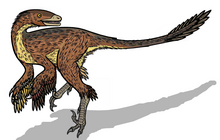Sinusonasus
| Sinusonasus | |
|---|---|

| |
| Life restoration | |
| Scientific classification | |
| Domain: | Eukaryota |
| Kingdom: | Animalia |
| Phylum: | Chordata |
| Clade: | Dinosauria |
| Clade: | Saurischia |
| Clade: | Theropoda |
| Clade: | Paraves |
| Family: | †Troodontidae |
| Subfamily: | †Sinovenatorinae |
| Genus: | †Sinusonasus Xu & Wang, 2004 |
| Type species | |
| †Sinusonasus magnodens Xu & Wang, 2004
| |
| Synonyms | |
| |
Sinusonasus is a
The
The holotype, IVPP V 11527, was found in the Lujiatun Member of the Yixian Formation, dating from the Hauterivian. It consists of a partial skeleton including skull and lower jaw fragments and partial tail, pelvis and hindlimbs. The fossil is compressed and partially articulated.[1]
Sinusonasus is a small troodontid. In 2010, Gregory S. Paul estimated its length at one metre, its weight at 2.5 kilogrammes.[3] The femur is 141 millimetres long.[1]
In 2004, several distinguishing traits were established. An interantorbital channel, connecting the
More generally, the head is relatively short, equalling 77% of the length of the thighbone. There are at least nineteen maxillary teeth per side. The front teeth are not serrated: those more to the rear only have denticles at the trailing edge. Five
Sinusonasus was in 2004 placed in the Troodontidae. It was presumed to have had a rather derived position, despite living in the Early Cretaceous. This was by the describing authors not interpreted as an indication for a long ghost lineage, troodontids developing earlier during the Jurassic than had been thought, but explained by rapid evolutionary change after a Cretaceous origin of the group.[1]
See also
References
- ^ a b c d e f Xu X. and Wang X.-l. 2004. "A New Troodontid (Theropoda: Troodontidae) from the Lower Cretaceous Yixian Formation of Western Liaoning, China". Acta Geologica Sinica 78(1): 22-26
- ^ Xu X., and Norell, M., 2006, "Non-avian dinosaur fossils from the Lower Cretaceous Jehol Group of western Liaoning, China", Geological Journal, 41(3-4): 419-437
- ^ Paul, G.S., 2010, The Princeton Field Guide to Dinosaurs, Princeton University Press p. 141
